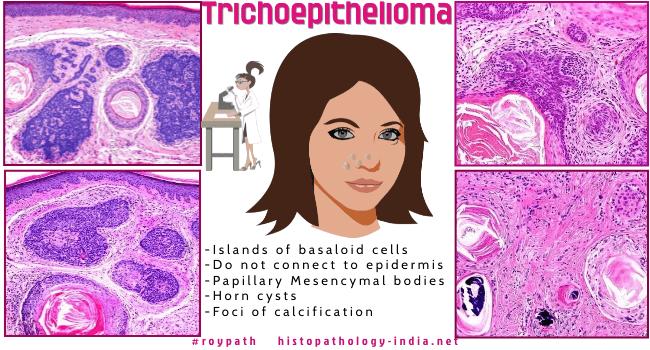|

Custom Search
|
|
Dermpath-India Pathology of Trichoepithelioma
|

Trichoepithelioma is regarded as a poorly differentiated hamartoma of the hair germ. The tumour has three clinical forms: solitary, multiple, or desmoplastic. Related post: Desmoplastic trichoepithelioma Although most classifications include this as a separate entity Ackerman and his colleagues have suggested that such tumours should be grouped together with trichoblastomas and use the term "trichoblastoma" for all tumours showing predominant hair germ differentiation. Site: Commonly located on the head and neck region. Solitary- Nose, upper lip and cheeks. Multiple- Central part of the face, trunk, neck and scalp. Clinical presentation: Skin coloured papules. May be solitary or multiple. Papules may coalesce to form plaques. Rare presentation is a linear form. Multiple tumours (epithelioma adenoides cysticum) inherited as autosomal dominant. Brooke-Spiegler syndrome: Multiple trichoepitheliomas and Cylindromas . Visit:Brooke-Spiegler Syndrome-[Pathology Infographic]
Immature trichoepithelioma: Typically exhibits no horn cysts, displays fewer primitive hair structures, and lacks the adenoidal growth patterns of the tumour lobules which are usually present in the classical trichoepitheliomas. Differential diagnosis : 1. Basal Cell Carcinoma: Distinction from some types of basal cell carcinoma has been based on the paucity of mitoses and apoptotic bodies, lack of retraction between stroma and epithelium and presence of primitive follicles in trichoepithelioma and differences in CD34 and bcl2 expression. However, there are some tumours in which this distinction cannot be reliably made. 2. Microcystic Adnexal Carcinoma ; 3. Trichoadenoma ; 4. Trichoblastoma ;
|
|
|



